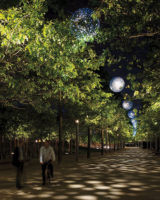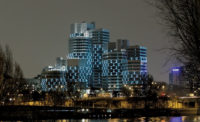When the Calgary Municipal Land Corporation tapped Civitas and W Architecture & Landscape Architecture to create a nature-based park on a 31-acre island in the city’s Bow River, the landscape architects called upon Tillett Lighting Design to provide contextual illumination with the delicate touch for which the firm is known. St. Patrick’s Island had been a park for over a century but suffered from neglect and disuse in recent decades. One of the goals of the design team was to maintain a viable habitat for birds, bats, and other wildlife. To achieve that, principal Linnaea Tillett and her team first identified how much of the park they could reserve as dark space. They layered this approach by also looking at how little light they could use, and only where it was essential for people using the park at night so that they would feel at ease and be able to find their way out. The lighting designers used a warm 3000K CCT for all the lamping, defining a major path (above) through the length of the park with well-shielded metal halide fixtures on tall wood poles. With two 50-foot-tall poles, each supporting four shielded adjustable metal-halide floodlights, the designers cast a moonlike glow on a central berm (opposite, top), used for nighttime sledding. Typically, the floodlights are shut off when the area is not in use. They also scattered low-level LED luminaires along secondary paths and LED wood bollards (right) in more open areas. Says Tillett, “We absolutely minimized our participation to maximize the territory left light-free for the birds.”










Post a comment to this article
Report Abusive Comment